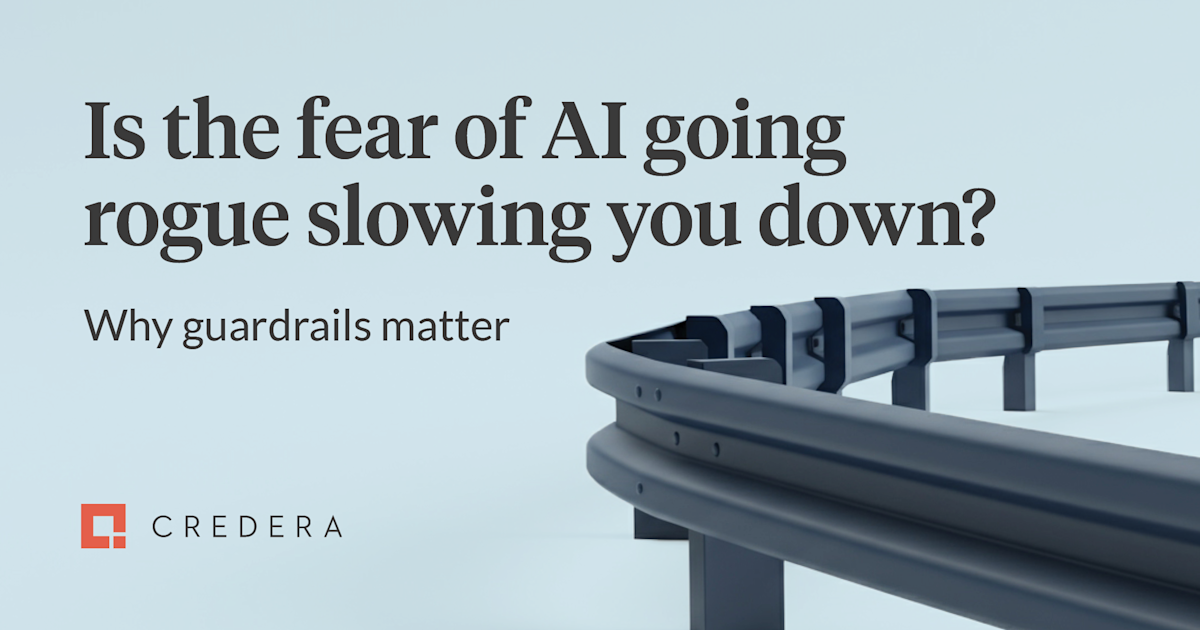
Worried AI might “go rogue”? You’re not alone. But with the proper guardrails, organisations can manage risk without stalling innovation. This article shows how layered controls work in practice and why fear doesn’t need to mean inaction.
Fear of AI behaving unpredictably isn’t just theoretical - it shows up in real conversations with our clients. We’ve seen everything from a total reluctance to explore GenAI, to suggestions that these systems be completely isolated from the rest of the organisation. While the instinct to isolate high-risk technologies is understandable, doing so often undermines the value of generative AI itself - its ability to interact with operational data, embed into workflows, and support live decision-making.
In most cases, thoughtful guardrail design provides a far more effective and sustainable way to manage risk without losing capability.
Why guardrails matter
Controlling generative models – or large language models (LLMs) - presents inherent challenges. Their complexity and non-deterministic nature can lead to unintended or biased outputs. Creators of LLMs approach these challenges differently: Anthropic employs constitutional AI, guiding model outputs through reinforcement learning and ethical principles. In contrast, Grok AI opts for minimal restrictions, facing criticism over potential safety issues.
Think of it like live TV broadcasts - anything can happen. Certain events (or AI applications) carry higher risks than others, prompting broadcasters to implement guardrails to limit exposure. Similarly, effective guardrails manage GenAI risks in a business context, balancing innovation with safety and responsibility.
What are guardrails?
Guardrails are mechanisms designed to keep generative AI outputs within safe and acceptable boundaries. They monitor and intervene proactively, preventing harmful, biased, or inappropriate content. When implemented effectively, guardrails ensure predictability and responsibility, protecting users and organisational reputations.
Returning to our TV analogy, broadcasters use short transmission delays, allowing producers time to replace inappropriate content swiftly. GenAI guardrails perform similarly, providing built-in oversight without significantly disrupting the interaction.
Effective oversight relies on multiple mechanisms. Let's explore front-end and back-end guardrails in detail.
Front-end guardrails
If you've interacted with chatbots like ChatGPT, you'll notice responses appear word-by-word, resembling a ticker tape. This streaming method ensures fluidity and responsiveness but introduces the risk of inappropriate content emerging mid-stream.
Front-end guardrails address this challenge by operating at the user interface level, enabling immediate intervention akin to an emergency brake for GenAI. Imagine a smart TV app allowing users to pause, skip, or mute problematic content instantly.
Key front-end mechanisms include:
Pausing or interrupting: Users or automated systems can halt content generation mid-stream upon detecting issues.
Content truncation or hiding: Problematic content can be concealed or shortened in real-time.
These measures are crucial but aren't always feasible, especially in API-based systems without direct user interfaces, which is where back-end guardrails become essential.
Back-end guardrails
Back-end guardrails operate within the AI generation pipeline, preventing harmful outputs from reaching users. Key strategies include real-time content moderation engines using classifiers and keyword detection, implemented as filtering layers between the model and its output.
These guardrails form a "preventive firewall," significantly reducing the chance of inappropriate content surfacing. Effective security, much like in other domains, relies on layered defences, combining rapid heuristic checks with detailed classifiers to provide both immediate intervention and thorough analysis. For example, multi-tiered back-end approaches can utilise initial quick-blocking mechanisms coupled with deeper, parallel, non-blocking reviews to optimise safety and user experience. Due to their resource demands and potential latency, careful planning and robust engineering practices are required.
Practical design considerations
With these guardrail mechanisms outlined, how should organisations practically approach their implementation?
When designing and implementing AI guardrails, here are several practical points to consider:
Identify specific risks: Assess the unique threats your organisation might face with GenAI, such as data privacy breaches, compliance failures, or misuse of AI-generated content.
Define guardrail responses: Decide how the system should react when a guardrail is triggered. Should it self-correct, halt processes to explain, or escalate for human intervention?
Evaluate guardrail delivery models: Consider whether your organisation is best suited for a turnkey "guardrails-in-a-box" approach or a customised guardrails-as-a-service model, aligning this choice with your organisational culture and capabilities.
Ensure ethical alignment: Establish ethical guidelines that your AI systems must adhere to, ensuring outputs remain fair, transparent, and unbiased.
Plan for continuous monitoring and adaptation: Implement observability platforms to monitor guardrail performance in real-time and adapt guardrails regularly as threats evolve.
Many organisations already have risk impact assessment frameworks in place. Increasingly, we’re seeing these evolve into AI-specific assessments, tailored to the unique risks and behaviours of generative models. It’s critical to involve legal and compliance functions early in shaping these processes, especially as AI regulations continue to develop rapidly across jurisdictions.
Addressing these considerations early will position your organisation effectively for safe, responsible, and innovative AI use.
Final takeaway
Fearing AI systems might "go rogue" is understandable but shouldn't cause inaction. Thoughtfully designed and well-implemented guardrails empower organisations to innovate responsibly and safely.
Whether you're beginning your GenAI journey or reassessing current protections, now is the time for action.
How Credera can help
At Credera, we frequently help clients navigate the concerns and complexities associated with GenAI risks and guardrail implementation. Our extensive experience - built over more than 20 years of delivering advanced data and AI solutions across industries including the public sector, health, and financial services - enables us to approach GenAI challenges with proven methodologies and deep expertise.
If you're looking to understand how to safely and effectively deploy GenAI within your organisation, or if you're seeking advice on refining existing guardrails, we’d welcome the opportunity to discuss your specific needs and goals. Contact us to explore safe, responsible AI implementation tailored to your context.
Contact Us
Let's talk!
We're ready to help turn your biggest challenges into your biggest advantages.
Searching for a new career?
View job openings


